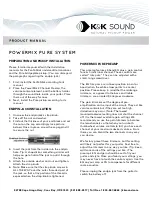
fr'{/!!^*il^L^y*^V/fy(ia,*W ^V,‘'i,,ilt*iwi*! I
i '
r'inrIrrtri"litf“fTwi^yiliB^A^Tft^niKT? •
|
d. Adjust the G A IN control for a signal amplitude of
4 cm oh the plug-in oscilloscope.
•I
1
e. Check the accuracy of the IF ATTEN dB selectors as
|
follows:
4?
1. Switch the 1 dB attenuator switch to O N and switch
Jj
out 1 dB attenuation through the Units Step Attenuator.
I
2. Check the display amplitude.
Must equal 4 cm
■-
± 0 . 5 mm (.1 dB/dB).
4
3. Switch the 1 dB IF ATTEN switch to the OFF posi-
tion, then check the remaining IF ATTEN steps as directed
I
in Table 6-3a.
|
Calibrotion— Type 1L30
Spectrum A n ayzer
IF ATTEN
Switch on
Step
Attenuators
Signal Am plitude
Limit (.1 d B /d B )
Units
Tens
1 dB
11
20
3.95 cm to 4.05 cm
2 dB
10
20
3.90 cm to 4.1 cm
4dB
8
20
3.8 cm to 4.2 cm
8dB
4
20
3.6 cm to 4.4 cm
16 dB
6
10
3.2 cm to 4.8 cm
20 dB
2
10
2.95 cm to 5.05 cm
The 1 and 2 dB measurements are very difficult because
of signal stability and the noise level. Over these small
»
signal levels the square law mode may be used. This ex-
1
pands the screen changes for the same level change by the
1
square power as listed in Table 6-3b.
TABLE 6 -3 b
dB
1
2
4
8
16
20
Signal
3.95
3.9
3.6
3.2
2.2
1.7
amplitude
to .
to
to
to
to
to .
limits
4.05
4.2
4.4
4.8
5.8
6.3
An alternate method which is not as accurate but is suf-
J
ficient for most applications is as follows:
i 1. Apply a — 60 dBm, 200 M Hz signal from the Signal
|
Generator to the RF INPUT connector. Adjust the Spectrum
|
Analyzer G A IN control, for a signal amplitude of 5 cm.
1
2. Switch the 1 dBm ATTEN switch on and adjust the Sig-
1
nal Generator Attenuator control to return the signal am-
S
plitude to 5 cm.
3. Check the new reading of the Attenuator dial. Should
read — 59 dBm ± 0 .1 dBm.
4. Turn the 1 dB ATTEN switch to OFF. Check the re
mainder of the IF ATTEN selector steps as directed in Table
6-3c.
.J
I
■
4
TABLE 6 - 3 c
. Spectrum A n a ly z e r
IF ATTEN switch O N
RF G e n e ra to r A tte n u a to r
Control Setting
2 dB
— 58 dBm ± . 2 dBm
4 dB
— 56 dBm ± . 4 dBm
8 dB
— 52 dBm ± . 8 dBm
16 dB
— 44 dBm ± 1 . 6 dBm
20 dB
— 40 dBm ± 2 . 0 dBm
10. Check Dynamic Range of Vertical Display
Modes
a. Equipment setup is given in step 9.
b. Apply a — 40 dBm, 200 M Hz signal from the Signal
Generator to the RF INPUT connector.
c. Adjust the Type 1L30 G A IN control a n d /o r the Signal
Generator Variable Attenuator for a signal amplitude of
6 cm (full screen display). Note the Attenuator reading.
d. Increase the Signal Generator Attenuator setting until
the signal is just visible above the noise level (about 0.5 mm).
Note the Attenuator reading. The difference in the two read
ings, between full screen display amplitude and the 0.5 mm
amplitude, is the dynamic range.
e. Check the dynamic range of each vertical display mode.
LIN, 26 dB or greater
LOG, 40 dB or greater
SQ LAW, 13 dB or greater
11. Check Attenuation Range of IF G A IN
Control
a. Equipment setup is given in step 10.
• b. W ith the G A IN control fully counterclockwise, adjust
the Signal Generator, Variable Attenuator control for a dis
play amplitude 6 cm. Note the Attenuator reading in dBm.
c. Increase the Signal Generator attenuation 50 dB. Turn
the G A IN control fully clockwise,
d. Check— Signal Amplitude must equal or exceed 6 cm.
(Range >50'd B .) If the range does not meet this requirement,
recheck the adjustment of the IF amplifier response (step 4).
12. Check Signal Amplitude a t RECORDER
Output Jack
a. Equipment setup is given in Fig. 6-20.
b. Plug the test phone plug, with a 600 fi load resistor
across the terminals, into the RECORDER jack. Connect a
1 X probe from the test oscilloscope across the 600 Q re
sistor.
6 -18
Содержание 1L30
Страница 48: ...si L i y n Maintenance Type 1L30 Fig 4 15 Honeycomb assembly drcui a n d component layout 4 n ...
Страница 59: ...Fig 6 1 A Test equipment required for calibration ...
Страница 60: ... Calibration Type 1130 ...
Страница 120: ...T Y P E I L 3 0 S P E C T R U M A N A L Y Z E R ib i IF SYSTEM BLOCK DIAGRAM 9 1 9 2 ...
Страница 127: ......
















































